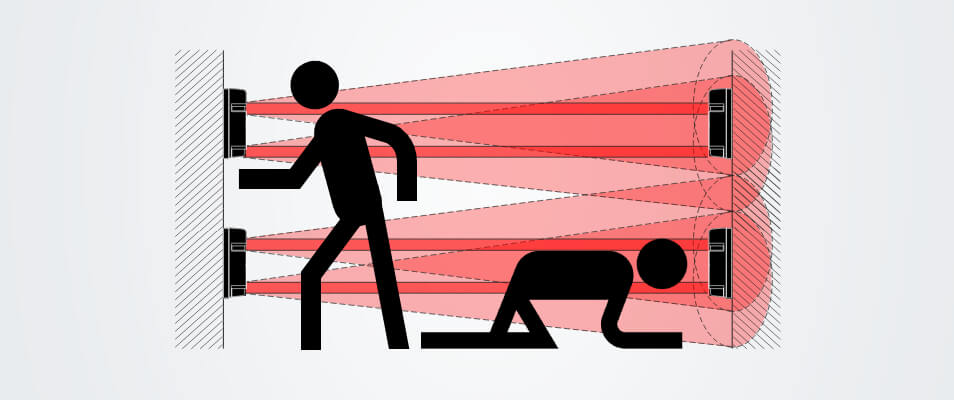- Show results for
- Share
How Does a Photoelectric Sensor Work?

Table of Contents
- What is a photoelectric sensor?
- Construction of a photoelectric sensor
- Detection methods
- Advantages of using a photoelectric sensor
- Where are photoelectric sensors used?
- TAKEX photoelectric beam sensors
- Why choose TAKEX devices?
- Options to consider
What is a Photoelectric Sensor?
A photoelectric sensor is a special device that determines the distance, absence/presence of an object. This sensor emits light and responds to its changes, generating an output signal.
Construction of a photoelectric sensor
Now, let’s consider the construction of a photoelectric sensor. Look at the scheme below:

A photoelectric sensor consists of the following components:
Main circuit
The power circuit supplies power to the elements of the sensor. The pulse oscillation circuit produces pulsed signal light from the LED. The photoelectric conversion circuit converts the received light to current. The electrical quantity is amplified by the amplifier. After that, if it is verified that the incoming light comes from the LED, the circuit sends a signal to the output circuit as an indication that the object is detected.
Light source
It emits light using the LED technology.
Light receiver
Special photodiodes & phototransistors receive the light emitted from the light source.
Output circuit
Depending on the signals received from the main circuit, the output circuit outputs on/off signals.
Detection methods
There are 3 main methods (modes) that provide target detection.
Diffused (or Proximity) mode

Both, the transmitter & receiver are in the same housing. The light from the transmitter strikes the target, which reflects light at arbitrary angles. In this case, some of the reflected light returns to the receiver, and the target is detected.
This mode allows the detection of multiple objects on a conveyor system as well as the detection of translucent objects, the fill level inside containers.
Retro-reflective mode

The transmitter & receiver are also in the same housing (like in the previous mode), however, in a retro-reflective sensor, a reflector is designed to reflect the light from the transmitter back to the receiver. The device detects the target when it blocks the beam from the photoelectric sensor to the reflector.
This mode offers longer sensing ranges than, for example, a diffused mode. A retro-reflective sensor is great for the detection of large objects as well as objects that are moving at high speeds, etc.
Through-beam (or opposed) mode

The transmitter & receiver have different housings. The light that comes from the transmitter is aimed at the receiver. When the target breaks the light beam, the output on the receiver activates.
Please note that this mode is considered to be very efficient. It is chosen for the detection of very small objects, spliced/overlapped materials, the precise location of a specific object, the contents of a container, etc.
Advantages of using a photoelectric sensor
If you compare the technology used in a photoelectric sensor to other technologies, you will find out that a photoelectric sensor has sensing ranges that surpass an array of technologies, including capacitive, inductive, magnetic, ultrasonic.
Photoelectric sensors are more popular due to their compact size, sensing range, and so on. On top of that, these sensors are cost-effective.
Where are photoelectric sensors used?
Security
No one will deny that security is important and it is true for homes where people live as well as for commercial buildings and industrial objects. A photoelectric sensor is a key part of a perimeter intruder system. There are a few things to think about before the installation.
Consider the environment the sensor will be used in. You have to know whether there are animals in the area (foxes, domestic pets, etc.); if there are plants that can interfere with the correct work of your photoelectric sensor; whether there are dips/rises in the length of the zone, and more. All these factors can affect the work of the sensor.

Industry
In addition, photoelectric sensors are widely used in various industries.
Photoelectric sensors are used for the control automation of manufacturing lines and more.
The list of industries includes:
- Food & Beverage Industry - on manufacturing as well as packaging lines, for example, for aligning an element (e.g. bottle cap) correctly.
- Automotive Industry - on the production line, to ensure that each component travels down the production line consistently.
- Machine Engineering - for the effective placement as well as removal of machine components.
- Material Handling - for automating the process of storing & stacking of products.
- Pharmaceutical Industry - for the packaging of medicines, these sensors can help to avoid empty packaging.

TAKEX photoelectric beam sensors
When it comes to a perimeter intruder system, the importance of the choice of sensors can’t be overstated. We recommend only the most effective solutions.
TAKEX offers reliable security sensors. The company’s point-to-point infrared detection is chosen by many customers for medium- as well as long-range perimeter intruder systems. Photoelectric beam detectors by TAKEX are designed to ensure excellent performance.

Why choose TAKEX devices?
The company is committed to excellence and uses state-of-the art technologies when designing its products. As a result, you get an advanced device that does the job perfectly well. The sensors are easy to install and use. As a rule, they are wired to a panel, however, you can connect your beams to a doorbell, lights, siren, and so on.
Options to Consider
There are different variants, let’s consider each one of them.
Twin Beams
These are the most widely used beams. Between the transmitter & receiver units, there are 2 beams. To activate the device, both of them must be broken. Applications include the protection of windows, doors, fences, driveways, and more.

Quad Beams
In this case, there are 4 transmitter points that are “connected” to 4 receiver points. As a result, we have 16 synchronized beam paths between the transmitter & receiver units. Quad beams will provide enhanced stability in a perimeter intruder environment.

TAKEX anti-crawl photoelectric beam sensors
Anti-crawl sensors are designed for the detection of crawling intrusion, the devices are ideal for demanding security applications (for example, military compounds, prisons). Note that these sensors are recommended to be used with TAKEX Quad beams, in this case, you will achieve the best result.

Photoelectric beam sensors can be mounted on a flat surface, on poles, or in towers. The latter option is very useful if there is no mounting point or if you want to hide the height and number of photoelectric sensors.
At Prime Buy, choose from a wide range of top-quality photoelectric sensors. All you need to do is to select the model that meets your needs and requirements. Shop with us!
